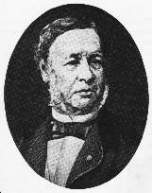

Renato M.E. Sabbatini, PhD
As the result of the experimental demonstrations carried out by Luigi Galvani and his followers, the electrical nature of the nerve-muscle function was unveiled. However, a direct proof could only be made when scientists could be able to measure or to detect the natural electrical currents generated in the nervous and muscular cells. Galvani did not have the technology to measure these currents, because they were too small. Electroscopes, the devices used in that time, were not sensitive enough. As a result, the study of bioelectricity almost disappeared from the scientific scene until 1827.
 In 1826, Johannes Müller (1801-1858), a noted German psychologist and physiologist,
proposed his theory of "specific nerve energies", which stated that different nerves (optical,
auditive, etc.) carried a kind of "code", which identified their origin to the brain. His position
was based on vitalism, a philosophical doctrine which affirmed that life was characterized by an intrinsic "vital
energy". However, it was important as the beginning of a whole new school of neurophysiological thought, which
eventually would refute vitalism as a valid concept in biology.
In 1826, Johannes Müller (1801-1858), a noted German psychologist and physiologist,
proposed his theory of "specific nerve energies", which stated that different nerves (optical,
auditive, etc.) carried a kind of "code", which identified their origin to the brain. His position
was based on vitalism, a philosophical doctrine which affirmed that life was characterized by an intrinsic "vital
energy". However, it was important as the beginning of a whole new school of neurophysiological thought, which
eventually would refute vitalism as a valid concept in biology.
 The stage for the revolutionary discoveries on nerve function which would be made in the
next decades was set against a background of continuous advances in anatomical knowledge about the nervous system.
In 1836, Robert
Remak described myelinated and unmyelinated
axons. In the next year Jan Purkyne
described cerebellar cells and identified the neuron nucleus and processes. Again in 1838, both he and Remak suggested
that the nerve fibers and nerve cells are joined (i.e., the nerve fiber or axons is a process arising from the
nerve cell). In 1839, Theodor Schwann
proposed the cell theory, i.e., that the nervous system is composed of individual neural cells.
The stage for the revolutionary discoveries on nerve function which would be made in the
next decades was set against a background of continuous advances in anatomical knowledge about the nervous system.
In 1836, Robert
Remak described myelinated and unmyelinated
axons. In the next year Jan Purkyne
described cerebellar cells and identified the neuron nucleus and processes. Again in 1838, both he and Remak suggested
that the nerve fibers and nerve cells are joined (i.e., the nerve fiber or axons is a process arising from the
nerve cell). In 1839, Theodor Schwann
proposed the cell theory, i.e., that the nervous system is composed of individual neural cells.


Jan Purkyne and Theodor Schwann
Then, in 1848-9, half a century after Galvani's
discovery, and thanks to the invention of the galvanometer
(made two decades earlier), the Swiss-German scientist Emil Heinrich Du Bois-Reymond (1818-1896), professor of physiology in Berlin and a disciple and sucessor of Johannes
Müller, was able to use a sensitive apparatus developed by him to detect what he called "action current" in the frog's nerve. It was named this way because Du Bois-Reymond noted a small
negative variation of the resting electrical potential in metallic electrodes connecting the nerve to a galvanometer
only when the stimulation of the nerve (mechanical or electrical) would elicit a response from the muscle. He was
able to demonstrate that this phenomenon of "negative variation" also occurs in striated muscle and is
the primary cause of muscular contraction.
|
|
|
|
Emil Du Bois-Reymond
and his |
Hermann von Helmholz |
The action current (later called action potential) was discovered to be a kind of "electrical impulse wave" which propagated at a fixed and relatively slow speed along the nerve fiber. In 1852, Hermann von Helmholtz (1821-1894) was able to measure the speed of frog nerve impulses, and determined it to be about 27 meters/second. Du Bois-Reymond contributions, published in his book "Untersuchungen über thierische Elektricität". ("Researches on Animal Electricity") in 1848, created the field of scientific electrophysiology. The work of both men served to refute the view by their teacher, Johannes Müller, that the nerve impulse was an example of a vital function that could never be measured experimentally, and their collaboration with a remarkable group of physiologists, composed by Carl Ludwig and Ernst von Brücke was very important to reduce physiology to applied physics and chemistry, a trend that has dominated physiology and medicine ever since. They had "sworn to each other to validate the basic truth that in an organism no other forces have any effect than the common physiochemical ones. . . ."
The impressive technological advances in the second half of the 19th century would advance the new field of electrophysiology.
Galvani and Volta![]()
 The
Field Advances
The
Field Advances
The Discovery of Bioelectricity
Renato M.E. Sabbatini
Brain & Mind Magazine 2(6), June/September
1998
Copyright (c) 1998 The State University of Campinas,
Brazil
Center for Biomedical Informatics